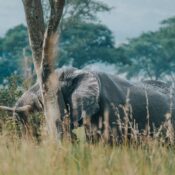Bushbuck
Bushbuck
Bushbuck (Tragelaphus scriptus)
Probably the most widespread antelope in Uganda is the bushbuck, which lives in forest, riverine woodland and other thicketed habitats. Close relative of the Kudu and Nyala, the bushbuck is a rather large antelope which relies on vegetation for cover. Bushbuck can be found in most of sub-Saharan Africa, especially in areas where it can easily be concealed.
Male bushbucks are bigger than females, with weights ranging from 40 to 80 kilos and shoulder heights from 70 to 100 centimeters. Females weigh about 25 to 60 kilos and are 65 to 85 centimeter tall. Only males have horns, which usually spiral once and are fairly straight, parallel to one another, and up to a half meter long. Females are usually a lighter brown than males. Both sexes have white spots and stripes, the patterns of which vary geographically. The male bushbuck has a dark chestnut coat marked with white spots and stripes. The female is lighter in colour and vaguely resembles a large duiker.
Although secretive and elusive, the bushbuck is very common in suitable habitats in most forests and national parks in Uganda.

Bushbuck
Behavior
Bushbuck are the least social of the African antelopes. They are often seen singly, although sometimes small groups of females and their respective young are found. These antelope are not territorial, and except for disputes over females in estrus they are not aggressive toward one another, so in areas with good quality habitat there may be several animals in close proximity. Therefore the traditional designation of them as “solitary” is somewhat misleading.
Bushbuck are mainly nocturnal, although they may also be active at dusk and/or dawn. The daytime is spent concealed from predators (which include virtually all carnivores their size or larger) in dense, bushy cover of the type that is usually found near rivers. They come out at night to feed in more open areas, but never venture far from some type of cover. They are very capable swimmers.

Bushbuck
Food Habits
When it comes to eating, these herbivores are browsers, they eat herbs and the leaves, twigs, and flowers of a large number of plant species. Although they will eat a wide variety of plant species when hungry, they are somewhat selective when possible, preferring knobbly creeper and sausage tree. They will also occasionally eat fresh grass.
Reproduction
The young can be born at any time of year, but in arid regions there is a peak in birth rates during the rainy season. Gestation requires only 180 days, allowing a female to produce more than one calf per year. A single calf weighing about 4 kg is born. The calf does not follow its mother out into the open to forage until it is four months old. It remains hidden in the dense underbrush in the mean time, and its mother returns periodically to let it nurse. Sexual maturity is reached at one year, but males’ horns do not reach full size until three years of age.
for more information visit
All Categories
Recent Posts
Kidepo Valley National Park
The Kabaka’s lake
What is the African elephant?
Tags
Quick booking process
+256 393254072


